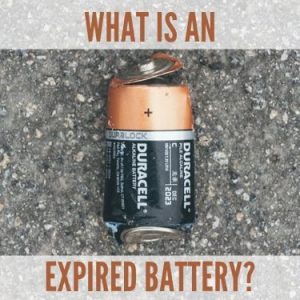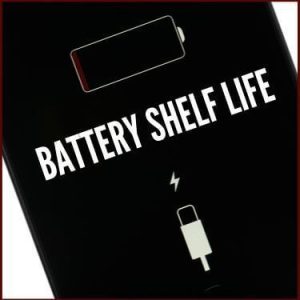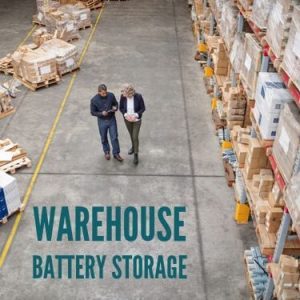
 Copy URL to Clipboard
Copy URL to Clipboard
It’s a fact. Battery shelf life is something you need to consider. You might know that batteries can deteriorate while they are in storage. Both rechargeable and disposable batteries need to be stored under special conditions. Don’t let expiring batteries short circuit your warehousing and fulfillment practices.
Battery shelf life has many considerations. Battery aging is influenced by three factors: the chemicals in the cell, how long it remains idle and storage temperature. From type of battery to storage temperature, there’s a lot to keep in mind.
Table of Contents

Different types of batteries require different storage options to help preserve shelf life. You’ll find a number of different types of batteries on the market available to today’s consumers. Before we delve into battery shelf life, let’s discuss the types of batteries and their applications.
Batteries generally fall into two categories:
Primary batteries cannot be recharged. You dispose of primary batteries when they are depleted. You’ll find primary batteries in many different forms. Everything from small watch batteries to the AAA batteries in your TV remote are primary batteries. These batteries are commonly used in applications where charging might not be practical.
Alkaline batteries are the most common kind of primary batteries. These batteries are generally friendly for the environment, affordable and do not leak even after they are discharged. Primary batteries have a shelf life of several years and have a good safety record.
Rechargeable batteries are known as secondary batteries. They can be charged again after depletion. Secondary batteries are typically used in situations where primary batteries might not be practical. You’ll find secondary batteries in devices like smartphones, electric vehicles and other high-drain devices. Secondary batteries can be more expensive up front, but cost-effective over the long term.
Secondary batteries are made of four main chemistries:
As technology evolves, we’ll need more batteries to power more devices. Part of using batteries is choosing the right battery for your needs. Here are some factors to consider when you’re selecting batteries:
Choosing the right battery for your application or project is important. With knowledge about the different types of batteries, it is time to delve into more information about storing batteries.
GET A QUOTE

When you think about expired battery, don’t think about expired food. When a battery has expired, it just means it has past its shelf life and the manufacturer can no longer guaranty how effective the battery will be. Battery expiration dates are based on the date when the self-discharge rate will be more than 20%.
The self-discharge rate is the rate at which a battery’s charge goes down as it remains idle. All batteries start to lose their charge as soon as they roll out of the manufacturer’s plant. The rate of this discharge, though, can vary based on the type of battery. Another contributing factor in the self-discharge rate might include the battery’s storage temperature.
In most cases, you can find a battery’s expiration date on the box or plastic packaging. Rarely will you find the expiration date printed on the battery itself. You’ll likely find the date printed near the chemical composition of the battery. Many times, the date will be obvious. It may be in highlighted from other text in a colored box or with another stand-out feature.
GET A QUOTE
All batteries self discharge during storage. However, proper storage can slow the discharge rate.
Battery shelf life is the length of time you can store a battery before it starts deteriorating. When it comes to battery shelf life, how you store the batteries is very important. Batteries and their content do best when stored in a cool environment. In fact, the ideal storage temperature for batteries is 59 degrees Fahrenheit. If cool storage isn’t an option, don’t worry. Many batteries can withstand temperatures up to 122 degrees.
Lead acid batteries should be stored at full charge. Other batteries, like lithium ion and nickel-based batteries, should be stored at a state of charge around 40 percent. Storing batteries like this can help reduce capacity loss while allowing for some self discharge. Storing batteries at the recommended state of charge can keep the battery operational.
Lithium-ion (Li-ion) batteries have a longer life cycle when they are stored at the right state of charge. Additionally, the state of charge can help make the batteries less volatile. This can ensure safe storage and transport.
Other types of batteries have different recommended states of charge.
GET A QUOTE

The shelf life of a battery depends on the kind of battery. Primary and secondary batteries have different kinds of shelf lives. Let’s explore the different chemistries of batteries and how long they can survive in storage.
Alkaline batteries are the most common kind of primary batteries. An alkaline battery’s runtime can vary based on the device in which it is used. Though it can vary by brand, alkaline batteries generally have a shelf life of 5-10 years when they are stored at room temperature. Alkaline batteries don’t have a life cycle because they can’t be recharged.
Carbon zinc batteries aren’t as common as alkaline batteries. They are a kind of non-rechargeable battery. They can be cheaper than alkaline batteries. However, they have less capacity. Shelf life for carbon zinc batteries is 3-5 years. There is no life cycle for carbon zinc batteries because they can’t be recharged.
Non-rechargeable lithium batteries are the longest lasting primary battery. They can have a shelf life of 10-12-years when stored at room temperature. The shelf life can be determined by the battery’s manufacturing process and chemical composition. You might find that in some cases, non-rechargeable lithium batteries have lasted up to 20 years. Like other non-rechargeable batteries, there is no life cycle.
Nickel cadmium is an older rechargeable battery technology. They are still useful in some applications, though. You might find that nickel cadmium batteries are more tolerant to temperature changes than other batteries. This means they perform better in colder and hotter climates than other rechargeable batteries. The shelf life for nickel cadmium batteries is typically 3 years. Nickel cadmium batteries have a long lifecycle. They can typically last up to 1,000 charges.
Looking for a battery high in energy density? Meet nickel metal hydride.The high energy density capacity means the batteries don’t have to be charged as often. The life cycle for NiMH batteries is approximately 700-1,000 charges. Because they have a high energy density, nickel metal hydride batteries don’t deplete as quickly. As a result, they have a shelf life of 3-5 years.
There are many kinds of rechargeable batteries on the market today. These include:
Because of differing chemistries, lithium rechargeable batteries perform differently. You might find that many manufacturers choose battery chemistry based on how the device is used. For most consumer electronics, lithium batteries last 600-1,000 life cycles. Lithium batteries have varying shelf lives. It depends on the battery’s chemistry and how it is used. Battery shelf life for a lithium battery can be between 2 and 4 years.
There are also many types of lead acid batteries. Acid batteries include pure lead acid, sealed lead acid and advanced glass mat (AGM) batteries. You might find that a security system runs off a lead acid battery. UPS (uninterrupted power supply) batteries are often lead acid. For the most part, lead acid batteries have a shelf life of 6 months. Pure lead-acid batteries have a shelf life of 8 years. Most lead acid batteries have a life of 200 charging cycles.
GET A QUOTE
There are a few things to keep in mind when handling batteries. Some batteries, like primary and alkaline batteries, require minimal precautions. Others, like spillable acid and lithium ion batteries require extra care.
When handling batteries, it is important that you use proper packaging. Battery terminals also need to be protected. The inside components should also be protected from metal objects like tools.
Other rules to follow when handling batteries include:
Following these guidelines when storing batteries in your warehouse or fulfillment center can help keep batteries safe and secure.
 Warehouse Battery Storage
Warehouse Battery StorageFulfillment warehouses that store and ship batteries need to be careful. You know that batteries have a finite shelf life and can only be in the warehouse for so long.
You’ll find it is wise to have a strategy when you are storing batteries in a warehouse. You might consider choosing a warehousing system like FEFO (first expiring, first out) or FIFO (first in, first out) when storing batteries. This will help keep things moving smoothly and ensure batteries have a maximum shelf life when they reach consumers.
There are a few protocols to follow when storing batteries in a warehouse. A climate controlled environment is a must when warehousing batteries. Heat and high temperatures can cause damage to batteries.
Here are a few of the common battery types and how they should be warehoused:
Storing batteries at home is a little different than storing them in a warehouse or distribution center. Storing batteries at home is just as important, though. Storing batteries in the correct way can help you make the most of your batteries’ shelf life.
Here are a few tips for household battery storage:
Don’t cause a short circuit in your logistics process. R+L Global Logistics can provide white glove logistics services to make warehousing and storing batteries simple.
R+L Global Logistics can handle your battery storage and shipping needs. Our extensive fulfillment and distribution services include:
Figuring out battery shelf life and how to ship batteries doesn’t have to be a hassle. Let R+L Global help with your battery shipment, warehousing, fulfillment and distribution needs. Call 866-989-3082 for additional information or to get started with logistics services.
GET A QUOTE

I am purchasing an off-grid solar power system with multiplle lithium-ion batteries. Did this the future of availability and price for them may not be available or too expensive. The package is on the way, but not ready to assemble it as our grid is still working. Should we end upas spmeeuropean countries, i.e. black outsit would be too late to find such systems. In the mean time, I dont know whet is the best way to store the batteries at idle. Should I charge/discharge from time to time or doas your article states to store them at 30-5-% discharge rate.